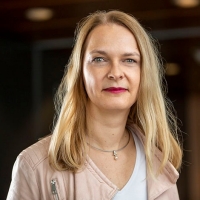Bettina Forget is a doctoral candidate in Art Education. Her research explores the intersection of art and science, and how transdisciplinary education may disrupt gender stereotypes. She owns and directs Visual Voice Gallery, which presents contemporary art that makes a connection to science. She is the Director of the SETI Institute’s Artist-in-Residence Program and VP and Director of Fine Art at the Convergence Initiative. Her creative practice fuses art and astronomy, and her artworks have been exhibited nationally and internationally. Her doctoral research has been funded by the Social Sciences and Humanities Research Council of Canada and a Renata and Michal Hornstein Doctoral Fellowship.
Blog post
Going to the Moon? Take a sketchpad with you!
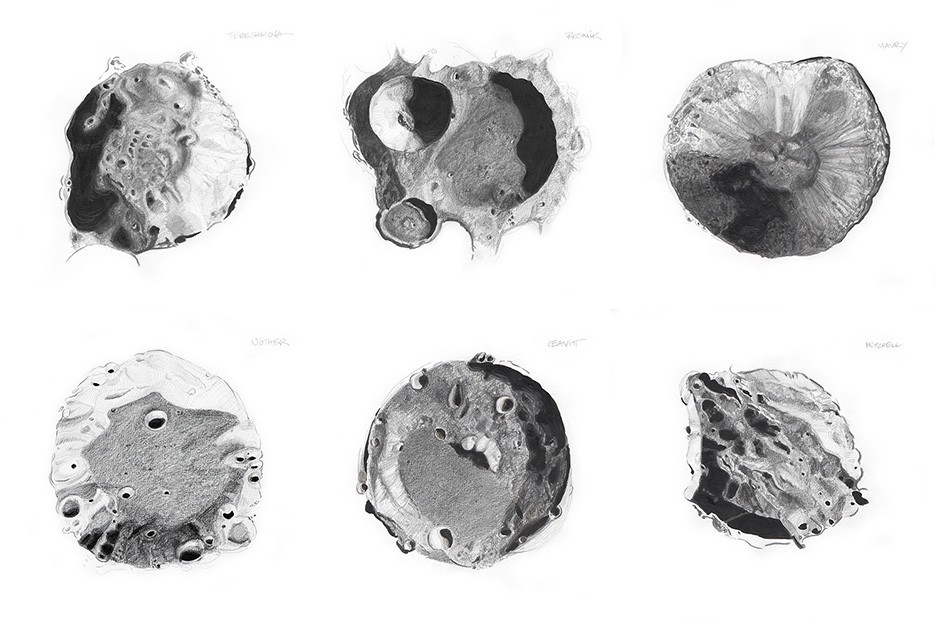 Bettina Forget, Women With Impact (detail), 2016 - ongoing, graphite and acrylic on paper
Bettina Forget, Women With Impact (detail), 2016 - ongoing, graphite and acrylic on paper
Drawing practice at the intersection of art and science
Our association with the word “drawing” is typically in the context of the visual arts: we think of a quick design draft, a life drawing in an art class, or a preparatory sketch for a larger artwork. However, the practice of drawing is also prevalent in the sciences. Microbiologists, for example, trace the outlines of small organisms as they wiggle on their slides, geologists note the patterns emerging from rugged landscapes, mathematicians create doodles to communicate abstract ideas with their colleagues. For both artists and scientists, drawing requires paying close attention to the world, and it provides a tangible representation of emerging thoughts. In effect, the practice of drawing is a convergence point of art and science.
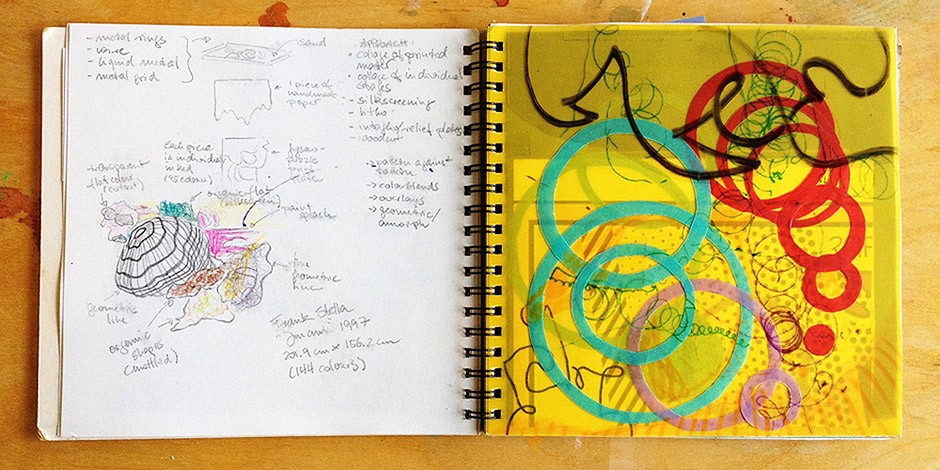 Bettina Forget, sketchbook
Bettina Forget, sketchbook
Drawing is research
Scholars in the field of contemporary art consider drawing to be, at its core, a method of inquiry. In the book Writing on Drawing, artist and author Anita Taylor describes drawing as research, explaining that drawing can “enable us to discover through seeing—either through our own experience of seeing, observing and recording or through the shared experience of looking at another’s drawn record of an experience” (p.9). Drawing can function as an anticipatory stage in idea development, a method of communicating complex ideas, a strategy for documenting information, or a mode of personal expression. In my own creative practice, and in my practice as an art educator, I use drawing to help me and my students to better observe, to comprehend, and to deeply engage with nature.
Sketching the Moon
The strategy of honing my observing skills through the practice of drawing is tied to my love of drawing at my telescope. Aside from being a trained artist, I am also an avid amateur astronomer. Since I live in Montreal’s Mile End, the light-polluted urban skies do not allow me to observe faint deep-sky objects like wispy nebulae or grainy globular star clusters. I can, however, easily spot the big, bright Moon. My 8” Dobsonian telescope transports me to the lunar surface and sends me floating over its desolate terrain. Rugged crater fields, cleft mountain ranges, and sinewy rilles silently float through the eyepiece as the Earth turns underneath my feet. It is a stark, desolate landscape, devoid of any colour, splashed with dramatic, unforgiving shadows. It is a perfect vista for sketching. To make my observing sessions more comprehensive, I like to record the objects I’m viewing in a log book, though, more often than not, I also take a small sketchbook along with me. Perched on a folding chair in near-darkness, with a small flashlight dangling from my neck and the sketchbook balanced on my knees, I make my drawings as I make my observations.
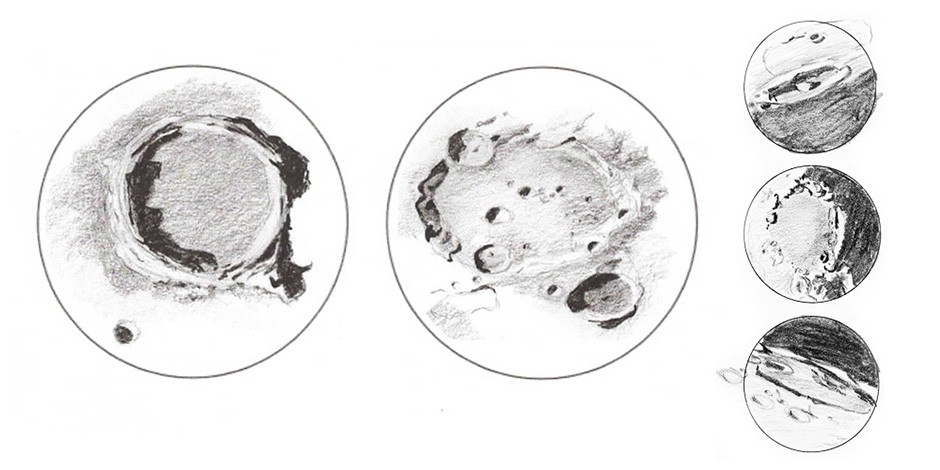 Bettina Forget, 2006 - 2014, sketches from the Observing Logbook, graphite on paper
Bettina Forget, 2006 - 2014, sketches from the Observing Logbook, graphite on paper
While I also occasionally simply hold my phone to the eyepiece and take a few photos, I find that drawing Moon craters allows me to better observe and understand the variety of crater types and structures. By sketching each crater, I notice the differences in shape, texture, and composition. Some craters, such as Plato, have unusually smooth crater floors, while others, like Copernicus crater, feature unique patterns of secondary craters or central peaks. Ancient craters tend to have furrowed, terraced walls, while small, young craters are typically smooth and bowl-shaped. Not only is my drawing practice helping me to better understand the various crater types, drawing also helps me to memorize each distinct crater. When I leaf through my sketchbook, I remember each observing session as though it was yesterday, and the Moon’s surface has become as familiar to me as my Mile End neighbourhood.
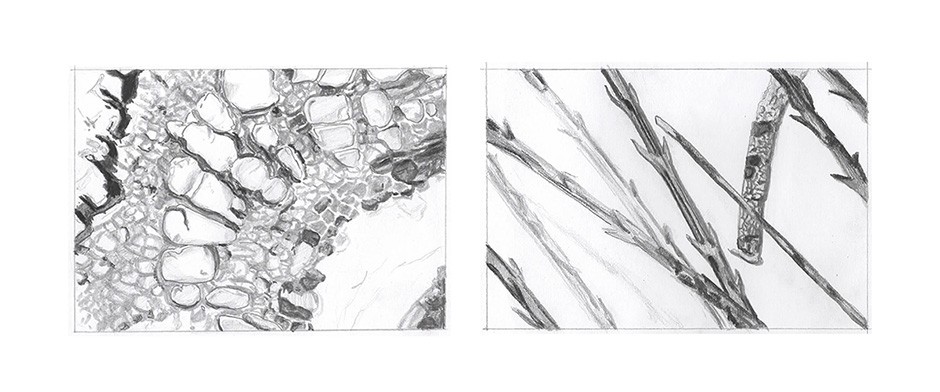 Bettina Forget, 2020, drawings of fern rhizome and dandelion pappus, graphite on paper
Bettina Forget, 2020, drawings of fern rhizome and dandelion pappus, graphite on paper
Microscopic worlds
When skies are cloudy, I transition from observing the very large to observing the very small: I swap my telescope for my microscope. I own a basic compound microscope, but I have recently discovered the more portable Foldscope, an ingenious folded paper microscope that integrates a single lens and a few magnetized adaptors. The microscope also snaps to a phone, which allows me to use its digital zoom. This little device magnifies up to 140x and I have used it to observe serrated dandelion seed pappus, murky river bed clay scraped off an anchor, and a hairy mite that was hiding in some lichen. (I am still on the hunt for the elusive tardigrade. There will be a photo and a post in ALL CAPS on my Twitter account when I spot one.)
Much like drawing Moon craters, the practice of drawing at the microscope’s eyepiece helps me to more closely observe and understand the world of the imperceptibly small. Here, I am following the path of pioneers such as Spanish neurologist Santiago Ramon y Cajal and German zoologist and artist Ernst Haeckel, who made stunningly detailed drawings at the microscope as part of their scientific research. Drawing at the microscope is particularly useful because the instrument’s shallow depth of field offers limited views of the object being studied. The microscope’s focus needs to be constantly adjusted to allow for a complete view of the item on the slide. The three-dimensional organisms under scrutiny reveal different details depending on the microscope’s plane of view. If you take a photo, only one focal range is visible at any one time. However, when I make a drawing, I can integrate several different focal points into one single image and produce a more complete representation of my subject. Since the advent of digital imaging technology the practice of drawing at the microscope is becoming a lost art, but some, like artist Gemma Anderson in her brilliant book Drawing as a Way of Knowing in Art and Science, advocate for its continued practice. I fully concur!
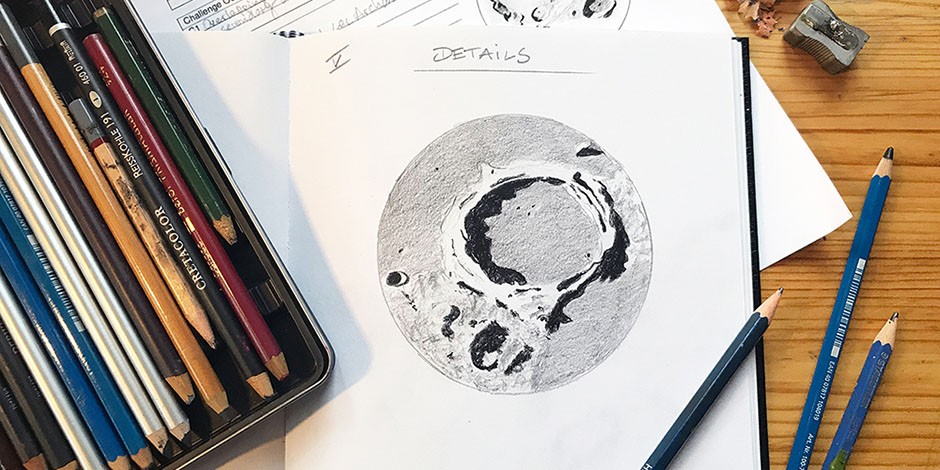 Bettina Forget, 2020, sketch of Archimedes crater, graphite on paper
Bettina Forget, 2020, sketch of Archimedes crater, graphite on paper
Teaching, learning, drawing
Drawing has been a fantastic tool for my own research and knowledge production, and it is also a method I introduce to my students when I am teaching art-science. Drawing sessions are integrated in the course Convergence: Arts, Neuroscience, and Society, as well as in my Ph.D. research, such as the recent Draw an Extremophile workshop that was presented in collaboration with 4thSPACE. My Moon sketching workshops, however, tend to be in more informal settings and act as of a form of public outreach. I first began to teach how to draw Moon craters to my fellow amateur astronomers when we were out in the field with our telescopes. If the sky clouded over during an observing session, I would invite my friends to my home and demonstrate basic sketching tips that are especially useful when drawing the lunar surface. For example, it is important to quickly outline all major features because the threat of could cover looms large and may unexpectedly halt an observing session. Also, there is no atmosphere on the Moon, so shadows are unforgivingly sharp and black. This is where I typically introduce the soft 6B pencils. Finally, there are some tricks on how to use a mix of pencil grades to effectively shade smooth crater floors and delicate ejecta blankets. Even those who professed to be absolutely incapable of drawing back in school produced convincing sketches, and the practice of drawing caught on in our astronomy club - and beyond. I have now lead Moon crater sketching workshops at the Montreal Planetarium, the Ontario Science Center, the Centre d’exposition de l’Université de Montreal, and online for Astronomers Without Borders. I have even trained a group of enthusiastic young amateur astronomers at the Royal Astronomical Society of Canada (RASC) to teach lunar sketching at public RASC events, and I’m delighted to see that astronomical sketching is taking off.
Drawing is for everyone
Whether you are a paint-splattered artist or a labcoat-wearing scientist, drawing is a shared practice that demonstrates that both art and science are grounded in a desire to observe, to document, and to understand. Each drawing becomes a part of us, as does the small part of nature that we commit to paper. The Moon crater becomes our Moon crater, the tardigrade our very own tardigrade. A drawing is an indelible artifact of exploration and wonder. I hope that, whatever your discipline of research, you will give your camera a break and reach for a pencil and paper as you continue to discover the world.
Note
I will be teaching another Moon crater sketching workshop in collaboration with the Cosmodôme in Laval during this year’s Journées de la culture on October 4, 2020. This will be the first time I will present the workshop en français. Watch my Twitter feed or the Journées de la culture website for a link to this free event.
About the author
